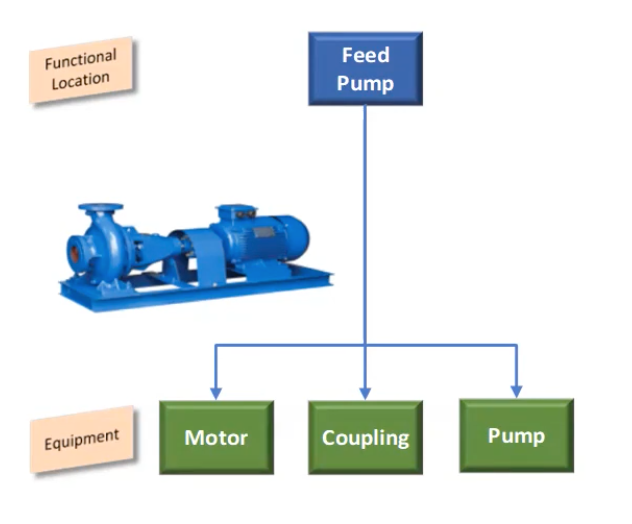In Asset Management, like many areas of life and business, it’s important to walk before you run—getting the basics right before bringing in advanced methods and technologies. Building the right processes enabled with the right people will ensure your company can execute strong asset management and maintenance practices.
No matter what level of asset management you are conducting, from basic repairs to advanced predictive planning, two data basics are at the core of all success: Logical location (described as functional location in SAP) and equipment. This information enables you to track an asset as it moves through installation, repair, and re-installation.
The Basic Asset Management Processes
Along with those two foundational pieces of data—logical location and equipment—two basic processes are part of any asset management and maintenance program: Asset Structuring and Work Management.
Asset Structuring Basics
The above picture is just one simple example of an asset structure using a pump, but asset structures are built for all assets, including transformers, sections of track, poles, wires, trucks, and more. Companies may choose how to structure their assets; these can be simple through to a complex structure driven by asset attributes.
The structure of assets is built on the way you search for them, the attributes of the asset, the attributes it inherits from the location, the maintenance planning information, and historical data for the asset.
Criticality is also an important attribute of an asset—how important is the asset’s function to the overall performance of the business? In rail, the network has turnouts, the turnout on the countryside that is used once every three weeks is not going to have the level of criticality as the turnout in a city centre that is used by nearly every train, every day.
Some unique asset structuring may come in the form of Linear Asset Management, which is for assets like roads, rail lines, and pipelines. Locations and point assets along these linear assets are marked by distance along the asset.
Assets can also have geospatial attributes. This is useful when your asset base is spread across large networks—electrical, rail, pipelines. Geospatial information allows for the grouping of locations and work, which can be very helpful in planning for outages.
For more information about Geospatial Enablement and SAP, check out our GIS Blog Series.
The Basics of Managing Your Asset Management Work
Managing work on assets are notifications and work orders are essential to get the basics right of EAM. Notifications are entered into the system as a request for work. These can be prioritised and converted into work orders. Work orders detail the jobs that need to be done. These can be scoped, planned, and then scheduled to be allocated to the people that need to complete the jobs.
Once a work order is created, these are steps that follow in managing asset work:
- Plan: Planning involves coordinating the internal labor, inventory, materials available, and those that can be purchased, as well as potential outside contractors, to complete the job.
- Schedule: Scheduling brings together personnel availability and skill, including job location in relation to work centers and the need for contract work, to efficiently complete jobs. Ideally, work schedules can bundle jobs together.
- Execute: Execution involves the right people at the right time in the right place with the right equipment to efficiently complete the job. This is the dream, the realisation of a great work management process.
- Close: Closing work is about stating what was done. This will close out the financial side of the work, and reporting fault codes and downtime so they can be recorded into the history of the asset.
Bringing the information from these steps in the work management process can then enable a deeper analysis of asset performance and work performance.
Building Your Maintenance Planning Maturity
As you get the basics right, your asset management program can begin adding capabilities. There are many levels of asset maintenance maturity—from basic repairs to planned maintenance, to inspection-based and condition-based predictive maintenance. The culmination is a fully predictive maintenance plan utilizing proven algorithms.
There’s no one answer to which model to use for all assets. It depends on the asset’s operation scenario.
Take a plane, for example. The engines would certainly be best off in the highest level of maintenance maturity possible. They are immensely critical. Seats, on the other hand, are often on a basic repair level. When the seat breaks, it is fixed or replaced. There’s no planning or predictive aspect. So, in one larger asset—a plane—different levels of asset maturity are involved.
The Basics are the Foundation
If you can determine the basic levels of data needed—logical location and equipment—and couple that with mastering the processes of asset structuring and work management, you can set the foundation for your asset maintenance maturity.
In building an asset management and maintenance program, you’ll start with the business side to figure out what you are trying to achieve and what will be needed to achieve it. Then you build, with an integrated solution like SAP.
For more to help get the basics right of asset management and maintenance, check out our on-demand webcast “Back to the Basics on Enterprise Asset Management.”


